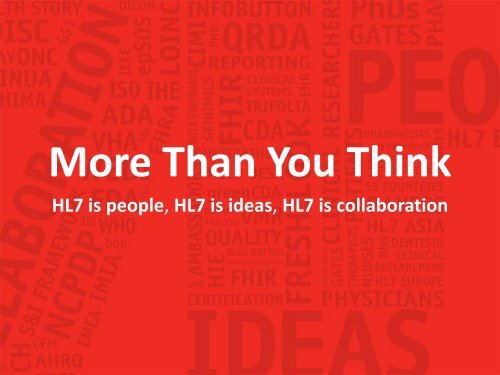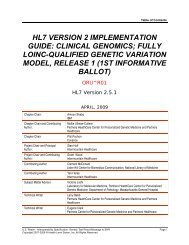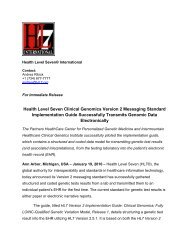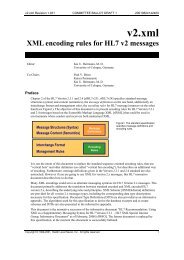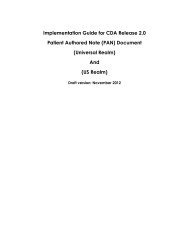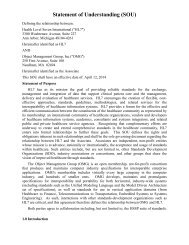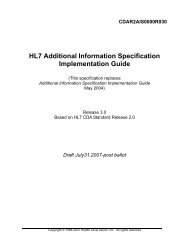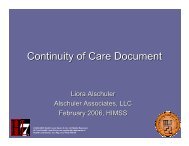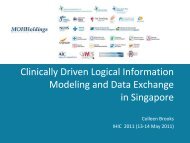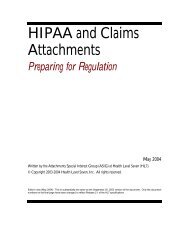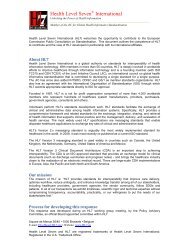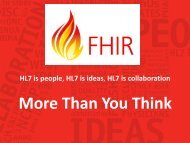Reference Information Model - HL7
Reference Information Model - HL7
Reference Information Model - HL7
- No tags were found...
You also want an ePaper? Increase the reach of your titles
YUMPU automatically turns print PDFs into web optimized ePapers that Google loves.
More Than You Think<strong>HL7</strong> is people, <strong>HL7</strong> is ideas, <strong>HL7</strong> is collaboration
More Than You Think<strong>HL7</strong> is people, <strong>HL7</strong> is ideas, <strong>HL7</strong> is collaborationIntroduction to:<strong>HL7</strong> <strong>Reference</strong> <strong>Information</strong><strong>Model</strong> (RIM)ANSI/<strong>HL7</strong> RIM R5-2012 and ISO 21731George W. Beeler, Jr. Ph.D.Co-Chair, <strong>HL7</strong> <strong>Model</strong>ing & Methodology CommitteePrincipal, Beeler Consulting LLCwoody@beelers.com
RIM Milestones• Concept proposed in 1992 by ANSI/HISPPJoint Working Group for a Common Data <strong>Model</strong> (in which<strong>HL7</strong> was a key participant)• <strong>HL7</strong> undertook development formally in 1997, building onmodels contributed by members• Process of Harmonization established to advance the state ofthe model• RIM 1.0 (first non-draft RIM) – Published Jan 2001• ANSI/<strong>HL7</strong> RIM Release 1 – Approved July 2003• ISO 21731 (RIM Release 1) approved 2006• RIM changed to ANSI “Continuous Maintenance Process”January 2009• Ballot of RIM R2 and R3 completed 2009 & 2010• Ballot of RIM R6 starts May, 2013© 2013 Health Level Seven ® International. All Rights Reserved. <strong>HL7</strong> and Health Level Seven are registered trademarks of Health Level Seven International. Reg. U.S. TM Office.
<strong>HL7</strong> – Version 3• Initial <strong>HL7</strong> standards (Version 2) were based on apragmatic ‘just do it’ approach to standards• <strong>HL7</strong> saw the need to revise and formalize the process‣ to assure consistency of the standards‣ to meet plug’n’play demands‣ to be able to adopt and leverage new technologies for both <strong>HL7</strong>and its users• Adopted the new methodology in 1997‣ based on best development & design practices‣ supports ‘distributed’ development across committees‣ is technology neutral© 2013 Health Level Seven ® International. All Rights Reserved. <strong>HL7</strong> and Health Level Seven are registered trademarks of Health Level Seven International. Reg. U.S. TM Office.4
<strong>HL7</strong> Version 3• Methodology based on shared models‣ <strong>Reference</strong> <strong>Information</strong> <strong>Model</strong> (RIM)• of the health care information domain‣ Defined vocabulary domains• Drawn from the best available terminologies• Directly linked to the RIM• Supported by robust communication techniques‣ Data Types model• Harmonization process that‣ Assures each member and committee a voice in the process, yet‣ Produces a single model as the foundation for <strong>HL7</strong> standards• Continuous balloting – begun in 2009 – produces a newrelease each year. R6 balloting begins May 20135© 2013 Health Level Seven ® International. All Rights Reserved. <strong>HL7</strong> and Health Level Seven are registered trademarks of Health Level Seven International. Reg. U.S. TM Office.
The “essence” of Version 3• Apply the ‘best practices’ of software development todeveloping standards – a model-based methodology• Predicate all designs on three semantic foundations –a reference information model, a robust set of datatypes, and a complete, carefully-selected set ofterminology domains• Require all Version 3 standards to draw from thesethree common resources• Use software-engineering style tools to support theprocess.© 2013 Health Level Seven ® International. All Rights Reserved. <strong>HL7</strong> and Health Level Seven are registered trademarks of Health Level Seven International. Reg. U.S. TM Office.6
1111111Normative RIM Release 1 in UMLParticipationActRelationshiptypeCode : CSActtypeCode : CSfunctionCode : CDclassCode : CS0..ninversionInd : BLEntityRolecontextControlCode : CSmoodCode : CSsource outboundRelationshiptargetinboundLinkRoleLinkcontextControlCode : CSclassCode : CSclassCode : CSsequenceNumber : INTid : SET0..n typeCode : CS0..n contextConductionInd : BLdeterminerCode : CSid : SETnegationInd : BLcode : CDplayersourceoutboundLink effectiveTime : IVLsequenceNumber : INTicationplayedRoleid : SETcode : CEnoteText : EDnegationInd : BLpriorityNumber : INTcode : CE0..10..n negationInd : BLtime : IVLderivationExpr : STtargetpauseQuantity : PQtext : EDinboundRelationshipquantity : SETaddr : BAG1 0..n modeCode : CE0..ncheckpointCode : CS: CE0..n1scopername : BAGscopedRole telecom : BAGawarenessCode : CEstatusCode : SET0..nsplitCode : CSdesc : ED0..10..nstatusCode : SETsignatureCode : CEeffectiveTime : GTSjoinCode : CSstatusCode : SETeffectiveTime : IVLsignatureText : EDactivityTime : GTSnegationInd : BLexistenceTime : IVLcertificateText : EDperformInd : BLavailabilityTime : TSconjunctionCode : CStelecom : BAGquantity : RTOsubstitutionConditionCode : CEpriorityCode : SETlocalVariableName : STriskCode : CEpositionNumber : LISTconfidentialityCode : SETseperatableInd : BLhandlingCode : CErepeatNumber : IVLinterruptibleInd : BLlevelCode : CEManagedParticipationindependentInd : BLid : SETuncertaintyCode : CEstatusCode : SETreasonCode : SETlanguageCode : CEEntityOrganizationEmployeeMaterialjobCode : CEPatientaddr : BAGformCode : CEjobTitleName : SCconfidentialityCode : CEstandardIndustryClassCode : CEjobClassCode : CEveryImportantPersonCode : CEsalaryTypeCode : CEsalaryQuantity : MOLicensedEntityhazardExposureText : EDprotectiveEquipmentText : EDrecertificationTime : TSSupplyProcedurePlaceManufacturedMaterialObservationSubstanceAdministrationquantity : PQmethodCode : SETAccountmobileInd : BLlotNumberText : STPatientEncountervalue : ANYapproachSiteCode : SETrouteCode : CEInvoiceElementexpectedUseTime : IVLaddr : ADexpirationTime : IVLpreAdmitTestInd : BLinterpretationCode : SETname : STtargetSiteCode : SETapproachSiteCode : SETAccessmodifierCode : SETdirectionsText : EDstabilityTime : IVLadmissionReferralSourceCode : CEmethodCode : SETbalanceAmt : MOdoseQuantity : IVLunitQuantity : RTOapproachSiteCode : CDpositionText : EDlengthOfStayQuantity : PQtargetSiteCode : SETcurrencyCode : CErateQuantity : IVLunitPriceAmt : RTOtargetSiteCode : CDinterestRateQuantity : RTOgpsText : STdischargeDispositionCode : CEdoseCheckQuantity : SETnetAmt : MOgaugeQuantity : PQspecialCourtesiesCode : SETallowedBalanceQuantity : IVLmaxDoseQuantity : SETfactorNumber : REALspecialAccommodationCode : SETpointsNumber : REALacuityLevelCode : CEWorkingListownershipLevelCode : CEFinancialContractDevicersonLivingSubjectContainerpaymentTermsCode : CEmanufacturer<strong>Model</strong>Name : SCt : EDsoftwareName : SCcapacityQuantity : PQtusCode : CElocalRemoteControlStateCode : CEheightQuantity : PQdiameterQuantity : PQDietDeviceTaskFinancialTransactionalertLevelCode : CEControlActPublicHealthCaselastCalibrationTime : TScapTypeCode : CEenergyQuantity : PQparameterValue : LISTamt : MOseparatorTypeCode : CEcarbohydrateQuantity : PQdetectionMethodCode : CEcreditExchangeRateQuantity : REALtransmissionModeCode : CEDiagnosticImagedebitExchangeRateQuantity : REALRoleParticipationActs• 4 Primary Subject Areas• 35 Classes• 181 Attributes• 9 Associations• 28 Generalizations© 2013 Health Level Seven ® International. All Rights Reserved. <strong>HL7</strong> and Health Level Seven are registered trademarks of Health Level Seven International. Reg. U.S. TM Office.
Action – the focus of health care• The reason we want to automate health care data is to beable to document the actions taken to treat a patient:‣ A request or order for a test is an action‣ The report of the test result is an action‣ Creating a diagnosis based on test results is an action‣ Prescribing treatment based on the diagnosis is an action• In simple terms, a medical record is a record of each ofthe individual actions that make up the diagnosis,treatment and care of a patient.© 2013 Health Level Seven ® International. All Rights Reserved. <strong>HL7</strong> and Health Level Seven are registered trademarks of Health Level Seven International. Reg. U.S. TM Office.
Five core concepts of the RIM• Every happening is an Act‣ Procedures, observations, medications, supply,registration, etc.• Acts are related through an ActRelationship‣ composition, preconditions, revisions, support, etc.• Participation defines the context for an Act‣ author, performer, subject, location, etc.• The participants are Roles‣ patient, provider, practitioner, specimen, employee etc.• Roles are played by Entities‣ persons, organizations, material, places, devices, etc.© 2013 Health Level Seven ® International. All Rights Reserved. <strong>HL7</strong> and Health Level Seven are registered trademarks of Health Level Seven International. Reg. U.S. TM Office.
RIM Core ClassesRoleLink0..* 0..*ActRelationship0..* 0..*11playsscopes1 11 10..*Entity RoleParticipation Act0..*0..*1 0..*1OrganizationLiving SubjectPersonMaterialPlacePatientEmployeeLicensedEntityAccessProcedureObservationPatient Enc’nt’rSubstance AdmSupplyReferralFinancial actWorking listAccount© 2013 Health Level Seven ® International. All Rights Reserved. <strong>HL7</strong> and Health Level Seven are registered trademarks of Health Level Seven International. Reg. U.S. TM Office.
Roles & Entities: “Played and Scoped”Downtown•HospitalScopedByDoctorJoe SmithUptownHospitalScopedByPatient© 2013 Health Level Seven ® International. All Rights Reserved. <strong>HL7</strong> and Health Level Seven are registered trademarks of Health Level Seven International. Reg. U.S. TM Office.
Is “Act” sufficient?• How can a single act class represent allof the elements of clinical action – theirdefinition, request, order, report?• Answer: the Act “mood” code –“A code specifying whether the Act is anactivity that has happened, can happen, ishappening, is intended to happen, or isrequested/demanded to happen.© 2013 Health Level Seven ® International. All Rights Reserved. <strong>HL7</strong> and Health Level Seven are registered trademarks of Health Level Seven International. Reg. U.S. TM Office.
Principle Act ‘moods’definition (DEF) – Definition of an act, formerly a “master file”intent (INT) – an intention to plan or perform an actrequest (RQO) – a request or order for a service from a request “placer”to a request “fulfiller”promise (PRMS) – intent to perform that has the strength of acommitmentconfirmation (CNF) – promise that has been solicited via an orderevent (EVN) – an act that actually happens, includes the documentation(report) of the eventCritical concept – “Mood” is not a status code. Each instance of the Actclass may have one and only one value for ‘mood’ Thus, an act in“order” mood that orders an act in definition mood and results in anAct in ‘event’ mood are three different acts, related through the actrelationship.© 2013 Health Level Seven ® International. All Rights Reserved. <strong>HL7</strong> and Health Level Seven are registered trademarks of Health Level Seven International. Reg. U.S. TM Office.
Mood code exampleAbstractActclassCode : CS = ??moodCode : CS = ??id : II = ??otherAttributesDefines a specifickind of observationObservationDefinitionclassCode : CS = OBSmoodCode : CS = DEFid : II = 123otherAttributesinstantiatesType knownMood abstractObservationclassCode : CS = OBSmoodCode : CS = ??id : II = ??otherAttributesOrders a definedkind of observationto be performedObservationRequestclassCode : CS = OBSmoodCode : CS = RQOid : II = O-02-35otherAttributesfulfillsPerforms the definedobservation tofulfill the orderObservationEventclassCode : CS = OBSmoodCode : CS = EVNid : II = 7986otherAttributes© 2013 Health Level Seven ® International. All Rights Reserved. <strong>HL7</strong> and Health Level Seven are registered trademarks of Health Level Seven International. Reg. U.S. TM Office.
Consider the Act of “Room Cleaning”• Mood: Proposal‣ PRP• Mood:Order/Request‣ RQO• Mood: Promise‣ PRMS• Mood: Event‣ EVNWhy don’t you clean your roomtoday honey?Clean your room!I will already!Room is cleaned.© 2013 Health Level Seven ® International. All Rights Reserved. <strong>HL7</strong> and Health Level Seven are registered trademarks of Health Level Seven International. Reg. U.S. TM Office.
RIM Core ClassesRoleLink0..* 0..*ActRelationship0..* 0..*11playsscopes1 11 10..*Entity RoleParticipation Act0..*0..*1 0..*1OrganizationLiving SubjectPersonMaterialPlacePatientEmployeeLicensedEntityAccessProcedureObservationPatient Enc’nt’rSubstance AdmSupplyReferralFinancial actWorking listAccount© 2013 Health Level Seven ® International. All Rights Reserved. <strong>HL7</strong> and Health Level Seven are registered trademarks of Health Level Seven International. Reg. U.S. TM Office.
Brief Survey of RIM• Basis of <strong>HL7</strong> V3 is single model with onlysix back-bone classes and a couple ofdozen specializations.• Abstracted by type hierarchies and “mood”• Displayed on a single 8-1/2 x 11 sheet ---© 2013 Health Level Seven ® International. All Rights Reserved. <strong>HL7</strong> and Health Level Seven are registered trademarks of Health Level Seven International. Reg. U.S. TM Office.
RIM Core ClassesEntityParticRoleAct© 2013 Health Level Seven ® International. All Rights Reserved. <strong>HL7</strong> and Health Level Seven are registered trademarks of Health Level Seven International. Reg. U.S. TM Office.
V3: All About ActsAct7classCode: CSmoodCode: CSid: DSETcode: CDstatusCode: CSeffectiveTime: QSET© 2013 Health Level Seven ® International. All Rights Reserved. <strong>HL7</strong> and Health Level Seven are registered trademarks of Health Level Seven International. Reg. U.S. TM Office.
Acts Have Class• ENC - Encounter• OBS - Observation (lab)• SBADM - Substance Administration (pharmacy -admin)• SPLY - Supply (pharmacy - dispense)• CLINDOC - DocumentAct.classCode :: CS (1..1) MandatoryConcept domain: ActClass© 2013 Health Level Seven ® International. All Rights Reserved. <strong>HL7</strong> and Health Level Seven are registered trademarks of Health Level Seven International. Reg. U.S. TM Office.
Acts Can Have CodesExternal codingsystems:‣ Lab Observation ActCodes could beLOINC codes.
Acts Have StatesAct.statusCode :: CS (0..1)Concept domain: ActStatus© 2013 Health Level Seven ® International. All Rights Reserved. <strong>HL7</strong> and Health Level Seven are registered trademarks of Health Level Seven International. Reg. U.S. TM Office.
Acts Have Moods…• Further clarifies the meaning of the Act (likeClass and Code)• Specifies if this act is an actual fact (event), or anintention to perform an act - such as a command,goal, appointment, or proposal.• Signifies a major modality or stage for which apermanent record must be obtained.• Never changes.• Alternatively, status can change. Status does notdefine the Act.Act.moodCode :: CS (1..1) MandatoryConcept domain: ActMood© 2013 Health Level Seven ® International. All Rights Reserved. <strong>HL7</strong> and Health Level Seven are registered trademarks of Health Level Seven International. Reg. U.S. TM Office.
Acts happen at specific times:Act.effectiveTimeDefinition:A time expressionspecifying the focal or operativetime of the Act, the primary timefor which the Act holds, the timeof interest from the perspectiveof the Act's intention.Data Type = General Timing Specification (GTS)Similar to V2 TQ repeat intervalAct.effectiveTime :: QSET (0..1)© 2013 Health Level Seven ® International. All Rights Reserved. <strong>HL7</strong> and Health Level Seven are registered trademarks of Health Level Seven International. Reg. U.S. TM Office.
Types of Act Relationships• COMP - has component• PERT - has pertinent info• SEQL - is sequel• OPTN - has option• FLFS - fulfills• RSON - has reason• INST - instantiates• PRCN - has precondition• OUTC - has outcome• ARR – arrived by• SUCC - succeeds• RPLC - replaces• OCCR - occurrence• REFV - has reference values• AUTH - authorized by• COST - has cost• GOAL - has goal• PREV - has previousinstanceActRelationship.typeCode :: CS (1..1) MandatoryConcept domain: ActRelationshipType© 2013 Health Level Seven ® International. All Rights Reserved. <strong>HL7</strong> and Health Level Seven are registered trademarks of Health Level Seven International. Reg. U.S. TM Office.
Participation• Describes the involvement of an entity in an act.• The entity is playing a role(Joe Smith plays doctor).• The role participates in an act. Examples:‣ Author [of an order](Ordering Doctor)‣ Admitter [of an encounter](Admitting Doctor)© 2013 Health Level Seven ® International. All Rights Reserved. <strong>HL7</strong> and Health Level Seven are registered trademarks of Health Level Seven International. Reg. U.S. TM Office.
Types of Participations• AUT - author• ENT - data entry person• CBC - call back contact• PATSBJ - patientsubject• ADM - admitter• PRF - performer• ATND - attender• CNS - consenter• DIS - discharger• SPC - specimen• LOC - location• CON- consultant• DST - destination• DEV - device• TPA - therapeutic agent• CSM - consumable• RESPROV -responsible providerParticipation.typeCode :: CS (1..1) MandatoryConcept domain: ParticipationType© 2013 Health Level Seven ® International. All Rights Reserved. <strong>HL7</strong> and Health Level Seven are registered trademarks of Health Level Seven International. Reg. U.S. TM Office.
Attributes have Data TypesRelease 2 of V3 Data Types was balloted jointly by<strong>HL7</strong>, ISO TC 215 and CEN TC 251• 10 Foundation: data types from which the rest are built, includescollection data types, boolean, etc.• 10 Basic data types including string, encapsulated data, coded datatypes, name, address, etc.• 7 Numerical and quantity data types, including numbers, money,and ratios• 10 Quantity collection types including intervals, discrete sets,unordered sets, etc.• 2 Uncertainty data types• 33 Flavors (specific constraints) of other data types, including“email address”, “organization name”,© 2013 Health Level Seven ® International. All Rights Reserved. <strong>HL7</strong> and Health Level Seven are registered trademarks of Health Level Seven International. Reg. U.S. TM Office.
RIM: Food for Thought• CDA Documents, V3 Messagesand FHIR are based on the RIM• Other objects could also be createdfrom the RIM.• Do you have an application for theRIM?• Some vendors are making theirinternal data models consistent ormappable with the RIM. They areprepared for V3 communication.Are you?© 2013 Health Level Seven ® International. All Rights Reserved. <strong>HL7</strong> and Health Level Seven are registered trademarks of Health Level Seven International. Reg. U.S. TM Office.
Thank You!George W. Beeler, Jr., Ph.D.Emeritus Staff, Mayo FoundationPrincipal, Beeler Consulting LLC211 2nd St NW Apt 1012Rochester, MN 55901(507)254-4810woody@beelers.com© 2013 Health Level Seven ® International. All Rights Reserved. <strong>HL7</strong> and Health Level Seven are registered trademarks of Health Level Seven International. Reg. U.S. TM Office.


